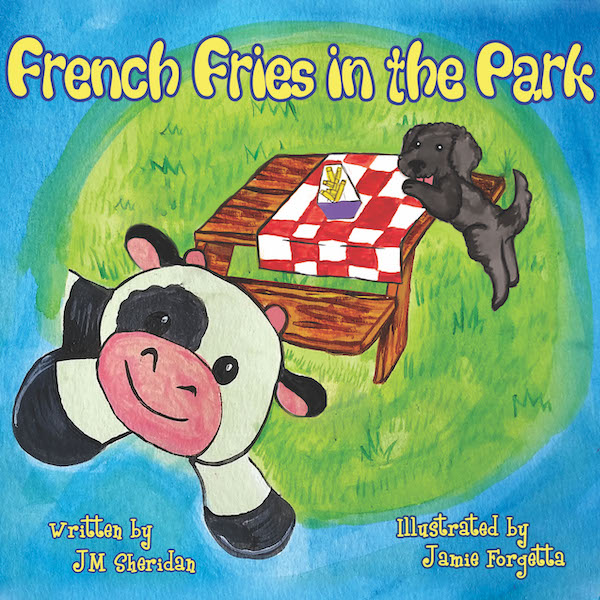French Fries in the Park: Encouraging Understanding, Acceptance, and Love

JM Sheridan is the author of the children’s book French Fries in the Park. Please welcome her and enjoy her guest post about the story behind French Fries in the Park.
The scene in the kitchen was heart-wrenching. My beautiful girl, tears streaming down her red cheeks, shaking from her distress. Next to her was my husband, Kevin, with his head in hands.
“I don’t know what is wrong,” he said wearily, “and she cannot tell me.”
Brianna was three and she was not speaking, save for a handful of words.
I looked down at the breakfast in front of her, and I knew. I don’t know how, but I did. As her cries continued, I quickly made a piece of toast, buttered it and cut it diagonally. I placed the warm bread in front of her and repeated, “Look toast.” I touched her softly until she opened her eyes to see the plate. Her sobs quelled as she reached out for the new toast and smiled.
I met Kevin’s questioning eyes. “I always cut her toast on a diagonal.”
That was eleven years ago. I have learned so much from Brianna: patience and understanding, acceptance, but more importantly she opened my mind to see the world from a different perspective. She has always been my muse. She inspires me in so many ways. Brianna was actually thrilled to be one of the main characters in the Brianna & Mrs. Moomoo series. The original Mrs. Moomoo is a small beanie baby cow that my good friend Mina gave Brianna when she was about one. Now that Mrs. Moomoo is a celebrity, she sits on a bookshelf in Brianna’s room guarded by other stuffed animals.
Throughout the years, Kevin and I have faced a number of challenges – most of which were derived from inexperience, unawareness, and prejudices. I wrote French Fries in the Park to be used as a source for discussion, whether in a classroom setting or at home, to help children understand what autism is and how it affects some kids. This story encourages them to be mindful and patient of the differences children with autism have, but also to recognize the similar wants and likes these children have that are the very same as their own.
In French Fries in the Park I carefully selected specific behavioral differences a child around the age of six would recognize and identify with. For example, no eye contact, being non-verbal, stimming, and parallel play rather than interactive play. Not only does Brianna notice each of these behaviors throughout the book, she gains a better understanding of them with the help of the boy’s father. She accepts this boy and his differences by continuing to stay with him in the park and play right alongside him.
In addition to discussions at home, I recommend that all preschool and elementary teachers and personnel be educated in the autism spectrum disorders, and that the administrators and education systems support this training. Knowledge is the key to a better understanding and a more accepting community.
Do you like what you see at DifferentDream.com? You can receive more great content by subscribing to the monthly Different Dream newsletter and signing up for the daily RSS feed delivered to your email.

By JM Sheridan
JM Sheridan lives in New England with her husband, Kevin, her daughter, Brianna, and four very mischievous kitties Sheridan attended the Institute of Children’s Literature in Connecticut, as well as numerous children’s book writing workshops, seminars, and classes. She is currently a member of the Association of Rhode Island Authors (ARIA) and Society of Children’s Book Writers and Illustrators. Dragonfly Magic and French Fries in the Park are the first books in the Brianna and Mrs. Moomoo series of books designed to educate and inspire children, as well as support our New England communities. You can learn more about her and her books at www.jmsheridan.com.
3 Comments
Submit a Comment
Subscribe for Updates from Jolene
Related Posts
The Lessons I Learned while Raising a Child with EA/TEF
Jolene Philo reflects on a lifetime of lessons learned while raising a child with EA/TEF and shares the insights she’s won.
Looking Back at Your Child’s EA/TEF Journey
Looking back at your child’s EA/TEF journey can give parents a new perspective about past events. Guest blogger Maggi Gale shares how her look back clearly showed her how God was with their family during their daughter’s very unusual first weeks of life in 2002. Three...
How Do I Let Go of My Adult EA/TEF Child?
Valeria Conshafter explores the question “How do I let go of my adult EA/TEF child?” for EA/TEF Awareness Month.






What a great resource! As a mom of a child on the spectrum, a special needs blogger, educational advocate and educator, this book would be invaluable for me and help to spread a lot of awareness!
Two of my three children are autistic and I have the moments like the “toast cutting” often. My children and I have also experience often that the children at the park say and do mean things bc of a last of understanding ASD and it’s painful. Your book sounds refreshing ❤️
This sounds like anawesome book!!